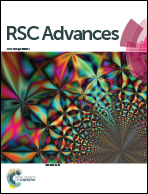Ultrasonic-induced nanocomposites with anatase@amorphous TiO2 core–shell structure and their photocatalytic activity†
Abstract
Disorder engineering on TiO2 nanocrystals (NCs) generates a nanocomposite with core–shell structure, which has been proven to achieve higher photocatalytic activity than the original TiO2 NCs. In this contribution, we engineered disorder layers around hydrothermally synthesized anatase NCs using the method of ultrasonic irradiation, obtaining anatase@amorphous TiO2 core–shell structure nanocomposites. The proportion of two phases (amorphism/anatase) in the nanocomposites was regulated by controlling the average diameter of the anatase NCs and the properties of the nanocomposites would change accordingly. The structure and photocatalytic activity of each sample were carefully compared to find out the appropriate synthesis conditions to obtain the optimal nanocomposite.


 Please wait while we load your content...
Please wait while we load your content...